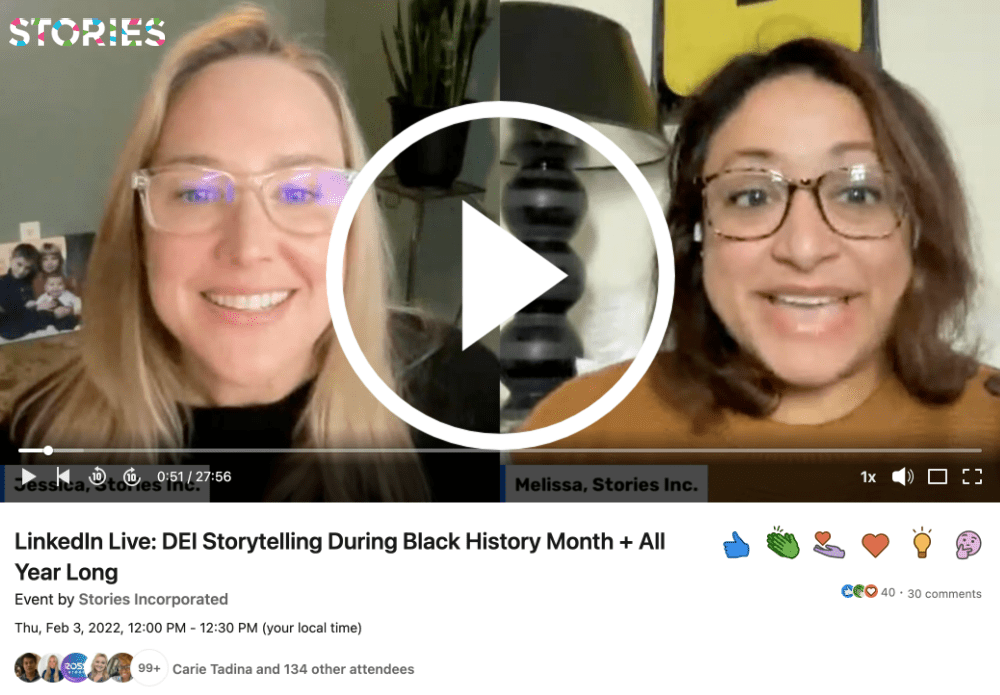Black History Month & DEI Stories LinkedIn Live: The Top Takeaways
How to share Black History Month stories in February, and diversity, equity and inclusion stories all year long — top takeaways from Stories Incorporated’s LinkedIn Live discussion.
Is it important for companies to join the conversations happening during Black History Month?
And, how do Black History Month messages work as part of an overall diversity, inclusion and belonging content strategy?
Stories Incorporated team members Melissa Jones, Content Strategist and Program Manager, and Jessica McFadden, Head of Marketing, took on those questions and more in a LinkedIn Live.
You can watch the full LinkedIn Live, DEI Storytelling During Black History Month and All Year Long, here:

And, here are the key takeaways from the discussion, as well as the content examples from leading companies shared during the Live.
Employee stories are a natural entry point for companies to celebrate Black History Month
Employee stories allow for a real way for companies to join the conversations surrounding important cultural celebrations … such as Black History month. February is a great time to honor Black history and people, especially within your company. Your posts can be a part of this national celebration, celebrating Black History Month with stories from team members.
DEI isn’t a single category or an annual nod. Amplifying the voices of Black employees and addressing anti-racism should be a constant, year-round element of your employer brand, infused throughout all of your culture content. Just as your company is—or should be!—increasing and improving its inclusion, diversity and belonging efforts, your content should follow suit.
The stories that Melissa and the Stories Inc. project team uncover from employees really bring commitment to equality to life. They allow companies to truly show dedication to preserving Black history … much more strongly than just a graphic or a famous quote.
For example, Labcorp team members who are members of their Employee Resource Group (ERG) for Black employees and allies share stories during Black History Month.
Cultural celebration stories serve as versatile DEI content
Employee stories that correspond to cultural events on the calendar can be used again at any date to communicate inclusion. Melissa and Jessica outlined how Stories and Labcorp built a DEI storytelling strategy and content plan centered around their ERGs and important cultural celebrations throughout the year. All in all, the Stories Inc. project team interviewed 23 Labcorp storytellers and developed 16 videos built around cultural celebrations such as Black History Month, Pride, International Women’s Day, Latino/Hispanic Heritage Month, Veteran’s Day. Get all the details on this content plan in the Labcorp case study.
As Melissa shared, “The videos were launched for the annual celebrations, but the stories are relevant all year long. These year-round communications reinforced Labcorp’s celebrations of inclusivity across its global organization.” Stories Inc. also developed a downloadable 2022 calendar that highlights important dates for DEI content creation needs.
Sharing stories from specific underrepresented groups shows inclusion towards that group as well as an overall culture of inclusion. And, these employee stories serve multiple audiences — they can recruit new employees, educate and engage existing employees, and provide a content library of stories to be used throughout an organization’s departments.
Not enough time to make a Black History Month video? Share employee stories in other ways
Jessica and Melissa let the culture marketers know that they shouldn’t be stressed about making an employee story video by the end of Black History Month. They offered solutions, such as interviewing employees via Zoom or phone and sharing their stories on your Lifeat or corporate blog.
“Written content is faster to create, and if you focus your content on employees’ real stories, their truth is easy to share – there’s no wordsmithing or rhetoric involved,” Jessica advised. She shared examples of great careers blogs fueled by employee stories.
Another solution that Melissa offered: celebrate Black History Month by really committing this year to capturing and amplifying stories from your Black employees, and team members of all underrepresented groups. Don’t worry about finalizing content by the end of February, but strive to share these stories the 11 other months of the year.
Employee storytelling should play an important part in every DEI/DIB and recruitment marketing strategy
Melissa has spent the last 17 years working at both Stories and Fortune 500 companies in roles across the HR specialist track, including university and diversity recruitment, internal rotational programs, diversity and inclusion, and recruitment marketing. Since coming to Stories, she has focused on working with companies and employees to share their personal stories and how they connect to key cultural messaging, such as inclusion and diversity.
Melissa shared, “Prospective employees are interested to hear about a company’s inclusion, diversity and equity promises and progress directly from the employees. They are the people who experience and form the culture that results from organizational actions, attitudes, and values. By encouraging your employees to tell their stories, companies provide a meaningful opportunity to create authentic communications discussing race and ethnicity, further demonstrating that you value and respect their experiences and their identities.”
An example of this, shared during the Live, was a story captured for Dell Technologies. It features Tiffany, a Black woman at Dell, and her story speaks directly to her experience with inclusion and career growth in the company. Dell features Tiffany’s story as one of the many team member voices during Black History month, as well as all year long.
Tiffany’s story gives viewers real life examples that demonstrate how she feels valued. And, her story showcases that Dell Technology employees’ identities and experiences matter and are celebrated.
Employee stories are the best way to prove your DEI progress
Real stories demonstrate that an organization appreciates and supports its employees, “…that they’re walking the walk, echoed through the positive experiences their employees have had as result of this support,” Melissa explained.
A company can post words on a webpage or corporate diversity and inclusion statement of how they support their employees. But those statements are most powerful when they’re actually backed up by the stories of their employees.
As an example, Melissa and Jessica shared the stories from the LexisNexis Fellowship initiative from its African Ancestry Network and LexisNexis Rule of Law Foundation.
This fellowship is part of LexisNexis’s overall commitment to diversity in the company, and the Fellows are focused on work to eliminate systemic racism in legal systems and build a culture of inclusion.
These stories can serve so many audiences: early careers, candidates interested in proof of culture and it also works during Black History Month. Significantly, these stories show LexisNexis is going beyond the confines of the workplace and actually contributing to diversity and inclusion in society at large in a new and unique way.

